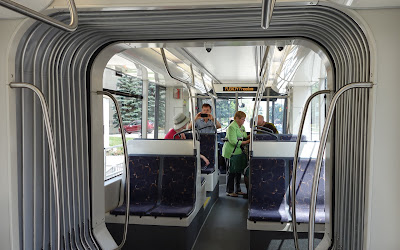Uptown Protected Bike Lanes?
Let's start with the changing attitudes. I've raised the Uptown Streetscape improvement plan before but this fall it came back to the public with a preferred option. One that included bike lanes and reduced traffic lanes. That on its own really says how far we've come! We can actually talk about converting uptown's King Street away from a 4-line thoroughfare, into a complete street serving all users.
But, as proposals go, it wasn't perfect. It's the barest of concessions to bikes and doesn't really provide a welcome cycling environment to attract serious use. So Graham Roe of Waterloo Bikes, as well as yours truly, both spent some time going over the possibilities of protected bike lanes in uptown Waterloo. I put together a detailed post up on TriTAG's blog, which led to a CBC radio spot to discuss the idea. Also, a lot of great conversations during and around the public consultation.
 |
| Protected bike lane on Kinzie in Chicago |
Graham has carried it further. He has spoken to the issue on radio as well, and even started and promoted a petition that edges towards one thousand signatures.
I think we've moved the needle on this one. But that is largely because it is an idea we're ready to seriously discuss, and a lot of people are realizing they'd bike if the infrastructure was accommodating. This matches what other cities have discovered-- just how many people would move around by bike if they felt it was safe and convenient.
 |
| Courtesy: Transitized |
And when you throw in a study which demonstrates the rise of alternative transportation in our uptown core, we can paint a picture of a city in transition, both in thought and action.
I might have accused Waterloo in the past of losing its mojo. It seems reports of its demise were greatly exaggerated.
But wait... there's more.
Waterloo Interior Loop is a Real Thing, except for the Loop part
The city of Waterloo presented its latest public information centre on the so-called Interior Loop that I posted about before. Details and boards from the latest PIC are available on the city's website here.
Options have been condensed to concrete proposals and intentions. While the "Loop" aspect of the Interior Loop is still lacking a key piece on its north side, the rest of the trail has received very detailed, systematic examination.
 |
| Just two of two dozen points of improvement. |
We see consistent crossing treatments, strong signage, trail infill, realignments and surface improvements. All to create a navigable, accessible trail. It's hard not to like, but easy to underappreciate-- this kind of systematic standard-setting usually just doesn't happen.
Okay, so there's still a failure to address the Weber St. crossing of the Laurel trail north of Lincoln. Only marginal improvements will be delivered there this time round. But on the other hand, we have real improvements that will be delivered in 2014, and are already budgeted.
Some of the expected (by me) local resistance to trail improvements has not emerged. In fact, I've heard support for the all-important resurfacing of Hillside Park trail from local residents along warnings about flooding problems that need to be handled.
Winter maintenance is still not on the cards, though.
Meanwhile...
Columbia St. W and Lexington Road Upgrades
Waterloo continues to knock off deficiencies in its east-west network. Out in the west end, a $10M widening project will add lanes, roundabouts, sidewalks and "raised" bike lanes to Columbia between Fischer-Hallmann and Erbsville. This marks the first use of raised or separated bike lanes in Waterloo. There's some chatter about whether the 4-to-2 lane adjustment makes sense on this stretch, but I'll leave that for others to worry about. Hopefully Waterloo also learned to do bike lanes and roundabouts better than this dangerous setup.
 | |
| DO NOT WANT |
East of the expressway, Lexington Road may see new sidewalks, bike lanes, and a multi-use trail between Davenport and University. The Public Information Centre for this is on Wednesday 11th December at Waterloo Mennonite Brethren Church (details). Can these changes be carried through successfully? It may depend on the reaction of residents on Lexington who may prefer to keep their streetscape as-is, if nobody else shows up.
I'll show up. Preserving "the look" and even a few trees can't trump basic human accessibility on foot. We're talking sidewalk on just one side, after all.
Of course, all this leaves an elephant in the room: the stretch of Lexington/Columbia between Davenport and King-- across the expressway, through four massively overspecced lanes, past a nasty choke point at Marsland and through busy Weber. This will be the hardest to deal with, but as I've pointed out before, the most necessary. Waterloo has already blinked once, but as the rest of this corridor comes together, it gets harder and harder to ignore.
What I'm wondering: with a proposed south-side multi-use trail east of the expressway, has someone tipped their hand? Does the city have something up their sleeve for overpass improvements? Has MTO softened their stance on bridge changes to improve walking and cycling?
What about Kitchener?
That's what's great about living in these twin cities. We have two (or four, including Cambridge and the regional government) chances to see good things done well. Of course, it's also two (or four) times as hard getting broad sweeping improvements through region-wide. You take what you can get.
Today, though, Waterloo gets the spotlight. They're bringing some really positive change forward, and more exciting change seems tantalizingly close.
Let's make it happen.




















